Properties:
Silver is the ‘pure metal’, literally as well as figuratively, which has led to its role in popular fiction as the ‘silver bullet’ needed to kill the werewolf (or the ‘beast within’). Because of its antimicrobial qualities, there are a number of silver products available for the prevention and treatment of infection, including silver-infused plasters and colloidal silver spray for throat and other infections. Pure silver can be placed on the Upper Heart Chakra or in the area of the infection during a treatment. Alternatively, if you have no native silver in your toolkit, good quality silver jewellery (without a stone) or a silver coin (not modern – modern coins contain little or no silver) can be used in its place. Silver has long been associated with the moon and the feminine principle, as well as Divine wisdom. Meditate with pure silver, either held or placed on the Third Eye, to connect with goddess energy, your own Divine feminine, or whatever you hold sacred, and place it on the altar during lunar rituals. Its reflective sheen means it is used as the backing for mirrors, and pre-digital photography would have been impossible without the light sensitivity of silver halides – so it is symbolically useful in helping us to ‘see clearly’, and as an aid to deep self-reflection. As it is a transmitter of energy, silver wire is often used in wands to finely direct healing energy, and is sometimes used to make pendulums. I strongly recommend that any jewellery worn for healing purposes is set in pure metal and worn on a pure metal chain, and silver is the best of these (although gold is appropriate as well for different reasons). Silver jewellery is normally 92.5% silver, alloyed with 7.5% copper or other metal to make it less malleable and prone to damage.
Attributes:
- Chemical Formula: Ag
- Birthstone: : Secondary birthstone for Cancer and Aquarius
- Chakra: Crown
Mineralogy:
- Silver is widely distributed in nature, but relatively rare. It occurs primarily in hydrothermal veins, and is often associated with copper. It tarnishes with a thin layer of black acanthite (silver sulphide) when exposed to sulphurous compounds, and apparently did not tarnish when exposed to air until the Industrial Revolution, when the air became laden with sulphurous pollutants. Crystals are not common, but when they form they are cubic, octahedral or dodecahedral. Silver also forms as aggregates and dendritically, often as elongated herring bone twins and wires. It is most often mined as a by-product of the refining of lead, zinc and copper, but is also mined from native deposits. Of all metals, silver has the highest thermal and electrical conductivity – even higher than copper – and would be more widely used in the electrical industry if it wasn’t for cost. It is still used in high-end audio equipment and printed electrical circuits. Its use in coinage closely followed that of gold, and it is highly valued in decorative and functional objects, as well as jewellery. Silver’s other main industrial use has been in photography, and it is also a medium for high-end musical instruments, particularly flutes.

Video Guide:
Save

